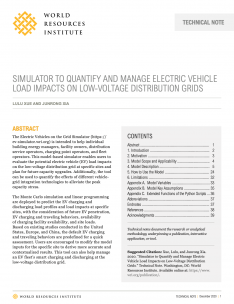Simulator to Quantify and Manage Electric Vehicle Load Impacts on Low-voltage Distribution Grids
The Electric Vehicles on the Grid Simulator (https://ev-simulator.wri.org/) is intended to help individual building energy managers, facility owners, distribution service operators, charging point operators, and fleet operators. This model-based simulator enables users to evaluate the potential electric vehicle (EV) load impacts on the low-voltage distribution grid at specific sites and plan for future capacity upgrades. Additionally, the tool can be used to quantify the effects of different vehicle-grid integration technologies to alleviate the peak capacity stress.
The increasing penetration of plug-in electric vehicles (EVs), including battery EVs and plug-in hybrid EVs, imposes a significant load on the low-voltage distribution grid, which consists of the low-voltage transformers and substations at a specific site. Accommodating the charging demands of EVs will involve expensive upgrades to local distribution systems. Nonetheless, vehicle-grid integration (VGI), as used in this study, enables EVs to provide grid services such as peak load shaving and to maintain an affordable and reliable distribution grid. To achieve this goal, EVs must have capabilities to manage charging or support two-way interaction between vehicles and the grid, which are referred to as “managed charging” and “vehicle-to-grid” (V2G).
The Electric Vehicles on the Grid Simulator (https://ev-simulator.wri.org/) is a model-based simulator that provides two main functions:
- It helps individual building energy managers, facility owners, distribution service operators, charging point operators, and fleet operators determine at what threshold EV adoption rates will overload the existing capacity of a transformer, a substation, or multiple substations in an area. It will also inform future low-voltage network upgrades, ensuring that EV load impacts do not exceed the current capacities of transformers and substations.
- It helps individual building energy managers, facility owners, distribution service operators, and charging point operators manage and optimize individual EV charging and discharging profiles through VGI measures to delay or possibly avoid expensive network upgrades (known as “distribution deferral”), reduce overall costs for electricity (known as “retail energy time shift” ), or consume on-site solar by leveraging EVs as a behind-the-meter energy storage system. In this case, the optimized EV charging and discharging profiles generated from the tool can be sent to charging points to directly manage the charging (or discharging) time and power of each EV.
The tool is not capable of modeling stationary storages or demand flexibility in buildings.
The Monte Carlo simulation and linear programming are deployed to predict the EV charging and discharging load profiles and load impacts at specific sites, with the consideration of future EV penetration, EV charging and traveling behaviors, availability of charging facility availability, and site loads. Based on existing studies conducted in the United States, Europe, and China, the default EV charging and traveling behaviors are predefined for a quick assessment. Users are encouraged to modify the model inputs for the specific site to derive more accurate and contextualized results. This tool can also help manage an EV fleet’s smart charging and discharging at the low-voltage distribution grid.
Projects

Sustainable Mobility
Visit ProjectSustainable Mobility Project aims to contribute to the development of low-carbon transportation in China, and build a green, efficient, inclusive and resilient urban mobility system.
Part of Sustainable Cities
Low-carbon transport
Visit ProjectWe work with national and local partners to develop medium- and long-term transport decarbonization roadmaps, formulate near-term key emission-reduction solutions, and facilitate global knowledge sharing, to achieve the low-carbon transition of China’s transport sector while ensuring social equit
Part of Sustainable Cities
